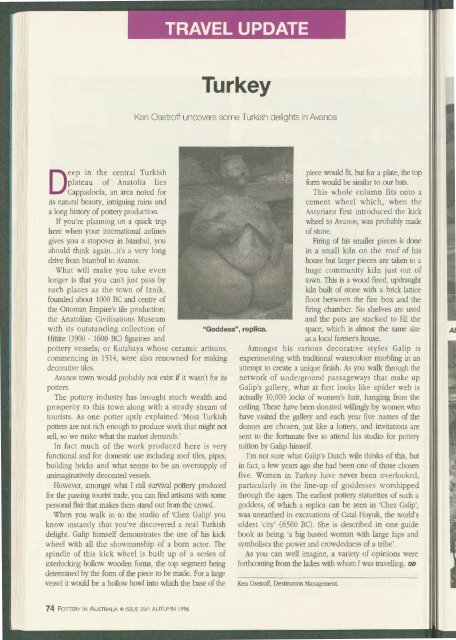Pottery In Australia Vol 35 No 1 Autumn 1996
Create successful ePaper yourself
Turn your PDF publications into a flip-book with our unique Google optimized e-Paper software.
Turkey<br />
Ken Osetroff uncovers some Turkish delights in Avanos<br />
I I<br />
Deep in the central Turkish<br />
plateau of Anatolia lies<br />
Cappadocia, an area noted for<br />
its natural beauty, intriguing ruins and<br />
a long history of pottery production.<br />
If you're planning on a quick trip<br />
here when your international airlines<br />
gives you a stopover in Istanbul, you<br />
should think again .. .it's a very long<br />
drive from Istanbul to Avanos.<br />
What will make you take even<br />
longer is that you can't just pass by<br />
such places as the town of Iznik,<br />
founded about 1000 BC and centre of<br />
the Ottoman Empire's tile production;<br />
the Anatolian Civilisations Museum<br />
with its outstanding collection of<br />
Hittite (1900 - 1600 BC) figurines and<br />
pottery vessels; or Kutahaya whose ceramic artisans,<br />
commencing in 1514, were also renowned for making<br />
decorative tiles.<br />
A vanos town would probably not exist if it wasn't for its<br />
potters.<br />
The pottery industry has brought much wealth and<br />
prosperity to this town along with a steady stream of<br />
tourists. As one potter aptly explained 'Most Turkish<br />
potters are not rich enough to produce work that might not<br />
sell, so we make what the market demands.'<br />
<strong>In</strong> fact much of the work produced here is very<br />
functional and for domestic use including roof tiles, pipes,<br />
building bricks and what seems to be an oversupply of<br />
unimaginatively decorated vessels.<br />
However, amongst what I call survival pottery produced<br />
for the passing tourist trade, you can find artisans with some<br />
personal flair that makes them stand out from the crowd.<br />
When you walk in to the studio of 'Chez Galip' you<br />
know instantly that you've discovered a real Turkish<br />
delight. Galip himself demonstrates the use of his kick<br />
wheel with all the showmanship of a born actor. The<br />
spindle of this kick wheel is built up of a series of<br />
interlocking hollow wooden forms, the top segment being<br />
determined by the form of the piece to be made. For a large<br />
vessel it would be a hollow bowl into which the base of the<br />
piece would fit, but for a plate, the top<br />
form would be similar to our bats.<br />
This whole column fits onto a<br />
cement wheel which, when the<br />
Assyrians first introduced the kick<br />
wheel to A vanos, was probably made<br />
of stone.<br />
Firing of his smaller pieces is done<br />
in a small kiln on the roof of his<br />
house but larger pieces are taken to a<br />
huge community kiln just out of<br />
town. This is a wood fired, updraught<br />
kiln built of stone with a brick lattice<br />
floor between the fire box and the<br />
firing chamber. <strong>No</strong> shelves are used<br />
and the pots are stacked to fill the<br />
space, which is almost the same size<br />
as a local farmer's house.<br />
Amongst his various decorative styles Galip is<br />
experimenting with traditional watercolour marbling in an<br />
attempt to create a unique finish. As you walk through the<br />
network of underground passageways that make up<br />
Galip's gallery, what at first looks like spider web is<br />
actually 10,000 locks of women's hair, hanging from the<br />
ceiling. These have been donated willingly by women who<br />
have visited the gallery and each year five names of the<br />
donors are chosen, just like a lottery, and invitations are<br />
sent to the fortunate five to attend his studio for pottery<br />
tuition by Galip himself.<br />
I'm not sure what Galip's Dutch wife thinks of this, but<br />
in fact, a few years ago she had been one of those chosen<br />
five. Women in Turkey have never been overlooked,<br />
particularly in the line-up of goddesses worshipped<br />
through the ages. The earliest pottery statuettes of such a<br />
goddess, of which a replica can be seen in 'Chez Galip',<br />
was unearthed in excavations of Cata! Hoyuk, the world's<br />
oldest 'city' (6500 BC). She is described in one guide<br />
book as being 'a big busted woman with large hips and<br />
symbolises the power and crowdedness of a tribe'.<br />
As you can well imagine, a variety of opinions were<br />
forthcoming from the ladies with whom I was travelling. oo<br />
"Goddess", replica.<br />
Ken Osetroff, Destination Management.<br />
AL<br />
74 POTTERY IN AUSTRALIA+ ISSUE <strong>35</strong>/1 AUTUMN <strong>1996</strong>

















